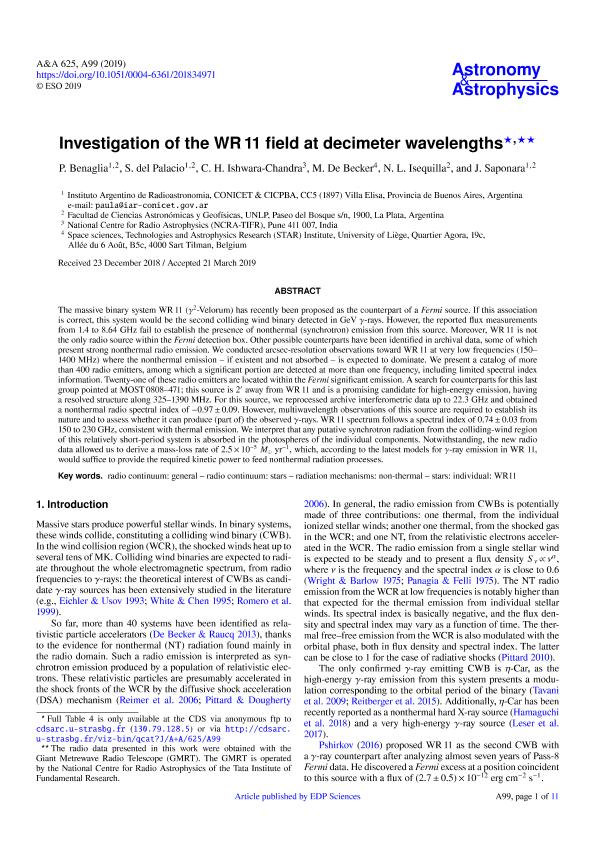Mostrar el registro sencillo del ítem
dc.contributor.author
Benaglia, Paula

dc.contributor.author
del Palacio, Santiago

dc.contributor.author
Ishwara-Chandra, C. H.
dc.contributor.author
De Becker, M.

dc.contributor.author
Isequilla, Natacha Laura

dc.contributor.author
Saponara, Juliana

dc.date.available
2020-12-30T12:32:29Z
dc.date.issued
2019-05
dc.identifier.citation
Benaglia, Paula; del Palacio, Santiago; Ishwara-Chandra, C. H.; De Becker, M.; Isequilla, Natacha Laura; et al.; Investigation of the WR 11 field at decimeter wavelengths; EDP Sciences; Astronomy and Astrophysics; 625; 5-2019; 99-109
dc.identifier.issn
0004-6361
dc.identifier.uri
http://hdl.handle.net/11336/121345
dc.description.abstract
The massive binary system WR 11 (γ2-Velorum) has recently been proposed as the counterpart of a Fermi source. If this association is correct, this system would be the second colliding wind binary detected in GeV γ-rays. However, the reported flux measurements from 1.4 to 8.64 GHz fail to establish the presence of nonthermal (synchrotron) emission from this source. Moreover, WR 11 is not the only radio source within the Fermi detection box. Other possible counterparts have been identified in archival data, some of which present strong nonthermal radio emission. We conducted arcsec-resolution observations toward WR 11 at very low frequencies (150-1400 MHz) where the nonthermal emission - if existent and not absorbed - is expected to dominate. We present a catalog of more than 400 radio emitters, among which a significant portion are detected at more than one frequency, including limited spectral index information. Twenty-one of these radio emitters are located within the Fermi significant emission. A search for counterparts for this last group pointed at MOST 0808-471; this source is 2´ away from WR 11 and is a promising candidate for high-energy emission, having a resolved structure along 325-1390 MHz. For this source, we reprocessed archive interferometric data up to 22.3 GHz and obtained a nonthermal radio spectral index of - 0.97 ± 0.09. However, multiwavelength observations of this source are required to establish its nature and to assess whether it can produce (part of) the observed γ-rays. WR 11 spectrum follows a spectral index of 0.74 ± 0.03 from 150 to 230 GHz, consistent with thermal emission. We interpret that any putative synchrotron radiation from the colliding-wind region of this relatively short-period system is absorbed in the photospheres of the individual components. Notwithstanding, the new radio data allowed us to derive a mass-loss rate of 2.5 × 10-5 M☉ yr-1, which, according to the latest models for γ-ray emission in WR 11, would suffice to provide the required kinetic power to feed nonthermal radiation processes.Full Table 4 is only available at the CDS via anonymous ftp to http://cdsarc.u-strasbg.fr (ftp://130.79.128.5) or via http://cdsarc.u-strasbg.fr/viz-bin/qcat?J/A+A/625/A99The radio data presented in this work were obtained with the Giant Metrewave Radio Telescope (GMRT). The GMRT is operated by the National Centre for Radio Astrophysics of the Tata Institute of Fundamental Research.
dc.format
application/pdf
dc.language.iso
eng
dc.publisher
EDP Sciences

dc.rights
info:eu-repo/semantics/openAccess
dc.rights.uri
https://creativecommons.org/licenses/by-nc-sa/2.5/ar/
dc.subject
RADIO CONTINUUM: GENERAL
dc.subject
RADIO CONTINUUM: STARS
dc.subject
RADIATION MECHANISMS: NON-THERMAL
dc.subject
STARS: INDIVIDUAL: WR11
dc.subject.classification
Astronomía

dc.subject.classification
Ciencias Físicas

dc.subject.classification
CIENCIAS NATURALES Y EXACTAS

dc.title
Investigation of the WR 11 field at decimeter wavelengths
dc.type
info:eu-repo/semantics/article
dc.type
info:ar-repo/semantics/artículo
dc.type
info:eu-repo/semantics/publishedVersion
dc.date.updated
2020-11-11T15:51:54Z
dc.journal.volume
625
dc.journal.pagination
99-109
dc.journal.pais
Francia

dc.description.fil
Fil: Benaglia, Paula. Provincia de Buenos Aires. Gobernación. Comisión de Investigaciones Científicas. Instituto Argentino de Radioastronomía. Consejo Nacional de Investigaciones Científicas y Técnicas. Centro Científico Tecnológico Conicet - La Plata. Instituto Argentino de Radioastronomía; Argentina. Universidad Nacional de La Plata. Facultad de Ciencias Astronómicas y Geofísicas. Observatorio Astronómico de La Plata - Sede Central; Argentina
dc.description.fil
Fil: del Palacio, Santiago. Provincia de Buenos Aires. Gobernación. Comisión de Investigaciones Científicas. Instituto Argentino de Radioastronomía. Consejo Nacional de Investigaciones Científicas y Técnicas. Centro Científico Tecnológico Conicet - La Plata. Instituto Argentino de Radioastronomía; Argentina
dc.description.fil
Fil: Ishwara-Chandra, C. H.. International Centre Of Theoretical Science. Tata Institute Of Fundamental Research; España
dc.description.fil
Fil: De Becker, M.. Université de Liège; Bélgica
dc.description.fil
Fil: Isequilla, Natacha Laura. Universidad Nacional de La Plata. Facultad de Ciencias Astronómicas y Geofísicas. Observatorio Astronómico de La Plata - Sede Central; Argentina
dc.description.fil
Fil: Saponara, Juliana. Provincia de Buenos Aires. Gobernación. Comisión de Investigaciones Científicas. Instituto Argentino de Radioastronomía. Consejo Nacional de Investigaciones Científicas y Técnicas. Centro Científico Tecnológico Conicet - La Plata. Instituto Argentino de Radioastronomía; Argentina
dc.journal.title
Astronomy and Astrophysics

dc.relation.alternativeid
info:eu-repo/semantics/altIdentifier/url/https://www.aanda.org/10.1051/0004-6361/201834971
dc.relation.alternativeid
info:eu-repo/semantics/altIdentifier/doi/http://dx.doi.org/10.1051/0004-6361/201834971
Archivos asociados
